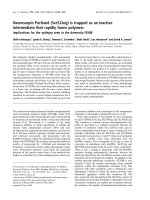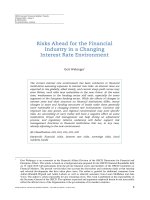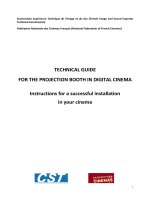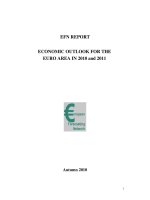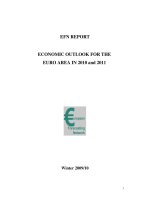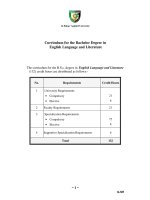FOR THE SAFE NAVIGATION IN JAPANESE COASTAL WATERS
Bạn đang xem bản rút gọn của tài liệu. Xem và tải ngay bản đầy đủ của tài liệu tại đây (19.62 MB, 204 trang )
FORTHESAFE
NAVIGATION
IN JAPANESE
WATERS
COASTAL
2003
#
Navigation
MaritimeTrafficDepartment
SafetyDivision,
J,apeuCoesr Gueap
Tableby SeaArea
f''---r(l ,
*/
a: Navigation
b: lnstructions
c: Chart
d: Information
e: Emergency
)
t
I
@ AkashiChannel
@ KanmonChannel
,-r-l
d)
O rokyo Bay
\
lse
Bay
@
@ BisanSeto
e
Channel
Kurushima
O Tokyo Bay
a. P68-81,87
b. Pg8-1 02
c. P198
d . P 15 8 e . P 19 5 , 19 6
@ Bisan Seto
a. P68-81,85, 86, 87
b. P121-127
c . P 19 8
d . P 16 0
e . P 19 5 , 19 6
@ lse Bay
a . P 6 8 - 8 1, 8 2 - 8 4 , 8 7
b . P 10 3 - 1 0 8
c . P 19 8
d. P164
e . P 19 5 , 19 6
@ K u r u s h i m aC h a n n e l
a . P 6 8 - 8 1 ,8 7
b . P 12 8 - 1 3 5
c . P 19 8
d. P161
e . P 19 5 , 19 6
@ RfashiChannel
a. PGB-81,
87
b. P112-119
c. P198
d. P159
e . P 1 9 5 1, 9 6
@ K a n m o nC h a n n e l
a.
b. P138-1 48
c . P 19 8
d. P162
e . P 19 5 , 19 6
Preface
Many marine accidents happen every year in Japan's peripheral sea areas and causes many
people to sacrifice their lives. In 2002,2,693 shipwrecks produced 165 deathsor missings.
Recently, there are no fluctuations in the number of shipwrecks of foreign ships, accounting
for nearly 9 percent of total marine accidents. In 2002, 252 foreign ships shipwrecked producing 47 deaths or missings. It is in view of the past examples of marine accidentsthat one shipwreck of a foreign ship produces much more deaths or missings compared with that of a
Japaneseship.
To eliminate shipwrecks of foreign ships, we have compiled this pamphlet by dividing
imPortant information, for the safety navigation of foreign ships within our peripheral sea area,
into four sectionsas follows.
1.
2.
3.
4.
Situationof the peripheryof Japan
Pilotageand navigation
law.
lnformation
for safe navigation
Keypointsof safe navigation
in it to havea smoothpassage.
Wewouldexpectyouall to makefull useof theinformation
NavigationSafetyDivision
MaritimeTrafficDepaftaent
JapanCoastGuard
as of July,2003
Note:
thesafetyof shipoperation,
Thisbrochure
is justa reference
datafor promoting
the Japaneselaws
andthosewhosail in sea areasnearJapanmustunderstand
naturally
andregulations
andthoroughly.
Due to partialrevisionof the surveylaw and channeloperationlaw,the
is changedto the world
latitude/longitude
usedin Japan'slawsand regulations
geodeticsystemfromthe Japaneselocaldatumon April 1, 2002. lt shouldbe
notedthatthe latitude/longitude
shownin thisbrochureis basedon theWGS-84.
- I -
f2rr"l'r-'l /"1Iu
1':'lri'f\:tt":Lti
CONTENTS
2001EDTION
PART1 CONDITIONS
IN SEAAREAS
AROUND
JAPAN
ChapterI
Marine Casualties
OccurringFrequentlyin SeaAreasaroundJapan
6
l. Occurrenceof MarineCasualties
2. Outlineof Marine Casualties
amongForeignVesselsin 2000
Chapter2
SeaandWeatherConditionsin SeaAreasalongthe Coastof Japan
8
L Fog
(1) FrontFog
(2) SeaFog
(3) Fog Information
2. Gale
(l) Wintermonsoon
(2) Cyclonepassingthroughthe southernshoresof Japan(Taiwan-Bozu)
(3) Cyclonefollowing the JapanSeacourse(Springstorm)
(4) Twin cyclone(Futatsudama
Teikiatsu)
(5) Typhoon
3. SeaConditions
( I ) Outline
(2) Oceancurrents
(3) Waves
Chapter3 Fisheriesin Watersalongthe Coastsof Japan
26
1. FishingGearandFishingMethods
2. VisualRecognitionof FishingVessels/Fishing
Gearand Recommended
Measuresto be
Taken
3. Fyke Net Fishing
-2-
PART2
PILOTAGEAND NAVIGATION
LAW
Chapter1 Pilotage"'
1. PilotageSystem
2. PilotageDistrict
3. CompulsoryPilotageSystem
48
Chapter2 NavigationalLaw
l. Summary
2. PortRegulationsLaw
3. Maritime Traffic SafetyLaw
4. Rulesof the Roadin Tokyo Bay and OtherBaysand Straitsin Japanese
Waters
50
PART3
INFORMATION
FOR SAFENAVIGATION
Chapter1 Local WeatherForecastandWarning
Chapter2
Noticesto Mariners
149
151
Chapter3 NavigationalWarnings'
152
1. NAVAREANavigationalWarning
2. JapanNavigationalWarning
3. RegionalCoast Guard Headquarters
NavigationalWarning.Coast Guard Office
NavigationalWarning
4. Maritime Traffic Information
5. SafetyMessage
-3-
Chapter4
InformationServicein Tokyo Bay, OsakaBay, Bisan Seto Area, and Kanmon
KaikyoArea
158
1. TokyoWan VesselTrafticAdvisory ServiceCenter(TokyoMARTIS)
2. OsakaWan VesselTraffic Advisory ServiceCenter(OsakaMARTIS)
3. BisanSetoVesselTrafficAdvisory ServiceCenter(BisanMARTIS)
4. KurushimaKaikyo VesselTrafficAdvisory ServiceCenter(KurushimaMARTIS)
5. KanmonKaikyo VesselTraffic AdvisoryServiceCenter(KanmonMARTIS)
6. NagoyoPortVesselTrafficAdvisory ServiceCenter
7. IsewanVesselTrafficAdvisory ServiceCenter(IsewanMARTIS)
Chapter5 Informationin Port
1. Port Operation
165
Chapter6
168
Uniform Systemof Buoyagealongthe Coastof Japan
Chapter7 Japanese
ShipReportingSystem(JASREP).....
l. Outline
2. ReportingProcedure
3. Communicationfrom JapanCoastGuard
4. Inquirieson JASREP
Chapter8 Communicationfor Maritime Disasters
1. DistressCommunication
2. CoastGuardOffices
-4-
. 174
188
PART4
Chapter I
Chapter2
GUIDETO SAFENAVIGATION
Information on Sea and Weather Conditions and Early Sheltering when There is a
Threat of Bad Weather
194
Canying on Board EssentialChartsfor SafeNavigations
197
of the Main EngineandEssential
Chapter3 VerifyingOperatingConditionsand Performance
Auxiliaries of the Ship through Starting/Stoppingand Go ahead/GoasternTrials
201
andTestsbeforeEnteringHeavily CongestedSeaAreas
-5-
PART1
Chapter I
IN SEA AREASAROUNDJAPAN
CONDITIONS
Marine CasualtiesOccurring Frequentlyin SeaAreas around Japan
A numberof marinecasualtieshavebeenoccurredin the seaareaaroundJapanat shortintervals. It is recommended
that anyonewho undertakesa voyageshouldrefer to this pamphlet
payingattentionto the reasonswhy the casualtieshaveoccurredso frequently,and also to the
everypossiblemeasurethat shouldbe takento preventthe reoccuffeence
of suchcasualties
1. Occurrenceof MarineCasualties
Japanis locatedin middle latitudesand is frequentlyvisitedby extratropicalcyclones,so
that it is subjectto majorchangesin seaandweatherconditions
Moreover,there are many dangerousareasfor ships navigatingin heavily congested
Tokyo Bay, Ise Bay, and the Seto Inland Seadue to geographicallyunfavorableconditions,
suchas naffow channels,sunkenrocks,and complicatedtidal currents. Increasingactivities
relatingto marinetransport,fisheries,andleisurehaveresultedin aggravatingcongestion.In
the seaareasalongthe coastsof Japan,therefore,marinecasualties
occurwith greatfrequency. Approximately2,500vessels,includingforeign and Japanese
vessels,meetwith marine
casualtiesin theseseaareasevery year. Consequently,
approximately170personsare found
(See
missingor dead
Fig. l-1).
Fig.1-1 The numberof rescueboatsmobillized
and the changein the numberof the
deadand missing
(boats)
3000
(person)
250
2500
200
2000
150
1500
100
1000
50
500
0
1997
1998
1999
2000
Legend:I
lMarine accident(unit:boats)
-G fne deadandmissing(unit: persons)
-6-
2001
2002
0
2. outline of Marine casualties among Foreign vessels tn2002
ln 2002, the number of marine casualtiesamong foreign vesselsin sea areasaround Japan
amounted to 252 (9.3Voof the total number of marine casualties),and the number of missing
or dead persons as a result of these casualtiesamounted to 47 (28.5Voof the total number of
missing or dead personsin all of the casualties).(SeeFig. 1-2.)
Fig.1-2 Changesin the Numberof ForeignVesselsRequiringRescueand Number
of Missingor DeadPersons
(boats)
300
250
(person)
70
255
261
248
261
51
218
200
/
252
-
47, 50
40
150
28
26,
100
30
-/
17,
50
0
60
1997
r
20
10
1998
1999
2000
Legend:n
(unit:boats)
Marineaccident
-G fne deadandmissing(unit:persons)
-7
-
2001
2002
Chapter 2
Sea and Weather Conditions in sea Areas along the Coast of Japan
The sea areas along the coast of Japan are subject to great changes in sea as well as weather
conditions, and this constitutesa grave threat to navigation.
In additon, there are many specific sea areas for military training and various kinds of fishing
grounds along the coast which obstruct fair passage.
All navigators are required to pay attention to the items described below, understandthe geographical featuresin these sea areas,and try to enhancethe navigational safety.
1. Fog
Of all the typesof fog that occurin the seaareasalongthe coastof Japan,the most stringent precautionsshouldbe takenfor front and seafogs. Thesefogs occur quite extensively
andoccasionallyremainfor half a day to a full oneday (SeeFig. 1-3 andTable l-2).
Fig.1-3 SeaAreasalongthe Coastof JapanWhereFogOccursFrequently
r- - - lsugoru
Korkyc
l_J
Wesiernport of Selo no kor
q--\-
Norlhern port of Kyushu
V c:n;tI ol Inubosok
\_l
Konto district
C o m m u n i c o t i o n s t o l i o n st h r o u g h w h i c h
f o g i n f o r , . n o t i o nr s p r o v i d e d
E o s t e r np o r t o f S e l o n o i k o i
Seto norkot
-8-
Table1-2 See areasalongshoreof Japanwherefog occursfrequently
Fog period
Mature
Stage
Vicinity of Inubo Saki
May-August
July
o\
\=/ Vicinity of Kinkazan
May-August
July
June
April-August
June A great deal of dense fog in seen espeJuly ciallv in Julv and Ausust.
May-August
July
See areas
o
/a\
\.J,/
TsugaruKaikyo
Vicinity of Erimo
@ Misaki Nemuro
(q,
Kuril's Ostrova
(Kurile Islands)
@ SetoNaikai
Remarks
Summer
period
During the summerperiod the islands
arepracticallycoveredwith fog.
March-July
Fog shows a sharp decreasewith the
end of the rainy season. In the circumference of Osaka Bay, Bisan Seto,
Hiuchi Nada, Aki Nada and Iyo Nada
fog occurs frequently.
Attention is to be given to Osaka Bay
even durins the winter monthes.
April
May
June
(l) FrontFog
This fog occursmost frequentyin springas well as in fall. It occursfrequentlyin the
rainfall areaon the north side of the cold front extendinsfrom the east-northeast
to the
south-southwest
andadvancingsouthslowly.
To put it anotherway, thereis a front extendingroughly from eastto west in the Seaof
Japan,andboth on its southsideand its northsidean isobarrunsroughlyparallelto it. On
the north side of the front, thereis rain and when the front goes southslowly, the most
stringentprecautions
becomenecessary.
(2) SeaFog
The rainy seasonis also a seasonof seafog. It is this seasonwhen casualtiesin fog
occurfrequently.(May,June,July)
The weathermap and an illustrationof cloud for a typical Bai-u (seasonal
rain) pattern
at 0900on June30, l9XX are shownin Figs.4 and5, from which it becomesquiteclear
rain) front extendingfrom eastto west,extenthat on the north sideof the Bai-u (seasonal
siveseafog occurs.(Referto Fig. l-4,5 andTable4.)
-9-
Fig.1-4 Weatherffiap,at 0900(JST JapanStandardTime)on June30, 1gXX.
n
'[ /.-L---\
. r\l_)
.,\>e/;>
'4,"
j
,''' 217'
L(6./2
---/-
Fig.1-5 lllustration
of cloudpictureat 0900(JST)on June30, 1gXX,
-10-
(3) Fog Information
When visibility is limited, fog information is provided through the following communication stations (See Table 1-3). Navigators are required to use this information effectively.
Table1-3 Fog Information
Communication
Sea area
Station
Broadcasting
criteria
Tohoku
District
The sea area off
Sanriku
Whenvisibility is
lessthan 1,000m
Kanto
District
Inubosaki/
Nozimasaki/
UragaSuido
Akashi Kaikyo/
Tomogashima
Easternpart
Suido/
of Setonaikai Naruto Kaikyo/
Osaka/Kobe/
Port of Himeji
Tanabe
Port of
Wakayama
Shimotsu
When visibility is
lessthanonenautica mile, 1,000m,
and500m or when
visibilityis
improvedto more
thanone nautical
mile
Bisanseto/
Westernport
Kurushima
of Setonaikai
Kaikyo
Kitakyushu
Kanmon Kaikyo
When visibility
is lessthan500m
stations:See Fig. 1-3
Locationof communication
- 1 1-
Calling Language Broadcasting
time
frequencyUsed
Fixed time
(8 times
everyday)
CHI6
Japanese/
English
Whenever
necessary
Fig.1-6 Wintermonsoon
Fig.1-7 Taiwan-Bozu
2. Gale
The following items can be pointed out for factors which bring about gale in Japanese
coastal waters.
. Winter monsoon
. Cyclone passing through the southern shores of Japan (The atmospheric depression
which develops near Taiwan towards the end of winter and visits the southern shores
of Japan causing snowfalls.)
. Cyclone following the Japan Sea course (Spring storm)
. Twin cyclones
. Typhoon
( 1) Winter monsoon
As shown in Fig. l-6, it occurs at the time of pressuredistribution where there is a continental anticyclone in the west and a deepenedcyclone in the Kurilian districts in the east.
Outbreak of the monsoon becomes extremely strong in caseswhere central pressureof the
central anticyclone exceeded 1,050 hPa. In such case, northwardly gale of more than 30
m/s sometimesblow.
(2) Cyclone passing through the southern shoresof Japan
Cyclone which occurred on the northeast shores of Taiwan develops quickly in most
cases. Since central pressuremay fall in some casesas much as l0 hPa or 20 hPa for 24
hours, leading to increasein the speed,special care should be given to it. (Fig. I -8)
This cyclone develops quickly extending of Shikoku and Kanto, resulting in such a
speed as about 60 Km per hour. Special care should be given to the case where central
pressure off Kanto dipped below 990 hPa. The reason is that it may develop further and
advance as far as the Kurile Islands or Kamchatka, and as a result the central pressuremay
frequently deepento a level ranging from 960 hPa to 940 hPa.
How far a storm zone of this cyclone extends goes as follows, if shown in Fig. l-7.
- 1 3-
F i g .1 - 8
q[l
1 4 0 ls0
\
\
\
Central pressure at formative stage
Central pressureafter 24 hours
E"p".t"d
*td
tp""d
atler 24 n
(3) Cyclonefollowing the JapanSeacourse(Springstorm)
When a distributionof atmosphericpressurefor winter in which the high pressurearea
lies to the west and the low pressurearealies to the east,abatesand a low pressuretrough
approachesfrom the continent,it is sometimespossiblethat cyclone will occur on the
EasternChina Seaor the Yellow Sea,enterthe JapanSeaand deepenquickly. In sucha
case,a southerlygaleragesthroughoutJapan.(Fig. 1-9)
-14-
F i g .1 - 9
(4) Twin cyclon (FutatsudamaTeikiatsu)
When cyclone which occurred in the vicinity of the Yellow Sea enters the Japan Sea and
develops quickly, while at the same time cyclone which occurred in China or the Eastern
China Sea, developing, moves eastward on the southern shores of Japan, it is called
FutatsudamaTeikiatsu. It comes together, however, off the coast of Sanriku and deepens
so much on the eastern shores of Hokkaido that it may frequently reach the same level as
t y phoon. ( F i g . 1 -1 0 )
Fig.1-10 Twincyclone(Futatsudama
Teikiatsu)
-15-
(5) Typhoon
The average course of typhoon classified by month, according to a statistical observation, goes as Fig. I - I I . As may be readily understood therefrom, typhoon having gone up
north turns to the northeast in the vicinity of lat. 20 degrees-30degreesN. on Japanese
waters and speeds up quickly. At the same time. it representsa time when the typhoon
develops exceedingly. On the top of it, attention is to be given to the fact that among
typhoons there is such a typhoon as to be called so-called stray one and take an irregular
course. In general, forecast of the typhoon course is based on upper wind. In addition to
it, following forecastsare possible in the light of empirical rules.
(a) It proceedsto the direction where the degree of pressurefall in exceedingly great.
(b) It proceedsto the direction where there is a rainfall area.
In any case, it is essentialto get continuous information and to take action to keep away
from the typhoon earlier than usual.
F i g .1 - 1 1 T y p h o o n
lL)
oo I
/
l-"
*"'
So---___..---__-_
roo-<]Jrn.
Oct.
-16-
3. Sea Conditions
( I ) Outline
From among various phenomena that occur in the seas,ocean currents, waves, and sea
ice are picked out as phenomenaclosely related to navigation and are summanzed below.
Oceanic phenomena have their own characteristic features and show great variations
which include seasonaland yearly variations. They frequently differ to a large extent from
natural phenomena. Particular care is required, therefore, when such oceanic phenomena
are to be interpreted or investigated.
of OceanCurrentsin JapaneseWaters
Fig.1-12 GeneralSituation
r55'
120"
45'
45"
V l o di v o s i o k
40"
4;:W
'fto&\
lirs\ j-----1
. l o
il'..{"
JJ
lc
tosl Lnrno
I
seo
l.-
30'
o
o
o
7eOkrnowo
IJ
l3
T o i w o n \ S u b - t r o p i c ocl o u n t e r c u r r e n t
oA'
l2o" .'.-
:'. O k i n o t o r i - s hmi o i s l o n d
LUZON
tlJ
r30"
140'
IJJ
-t7-
145'
20'
r50"
(2) OceanCurrents
a. KuroshioCurrent
The Kuroshio Current or the Black Current (refer to Fig. l-12) is also called the
JapanCurrent. It is the largestoceancurrentin Japanese
waters,and the only current
that can standcomparisonwith it in the whole world over is the Atlantic gulf stream,
althoughthe Antarctic circumpolarcurrent exceedsboth in the amount of water flowing. The Kuroshio Current is a high-temperature,
high-salinitywarm current that is
dark blue color as is impliedby its nameandhasa transparency
of morethan30 metres.
Its flow rate is 2 to 3 kn on the averageand reachesup to 4 to 5 kn, and its watercourse
changesmoreviolentlyin directionthanis usuallyanticipated.It is alwaysimportantto
pay attentionto the movementof the KuroshioCurrentas it has a greatinfluenceon
navigation.Navigatorsarerequiredto takenoticenot only of informationas to the passageof current,surfacetemperature,and flow rate of the Kuroshio Currentsummarized
below,but also of the latestinformationprovidedby the Maritime SafetyAgency with
regardto oceancurrentreports,etc.
Passage of the current
The sourceof the Kuroshio Current is east of the PhilippineIls., where the North
Equatorial Current separatesnorth and south and where the northward branch then
flows northwardoff Luzon. The Kuroshio Current then passesthroughthe sea area
betweenTaiwanand Yonakuni-jimaIsland,and flows into the East China Sea. It then
advancesnorthwardalong the outer edge of the continentalshelf and passesthrough
TobaraKaikyo to the South Sea areaof Japan. Part of the Kuroshio Current branches
off from the main currentin the seaareaeastof Taiwan and flows eastwardto turn into
a subtropicalcountercurrent.Part of the upper streamof the Kuroshio Currentbranches
off from the main currentin the seaareawest of Okinawa,advancesnorthwardalong
the west of Kyushu,and flows into the JapanSeathroughTsushimaKaikyo to become
theTsushimaOceanCurrent.
The KuroshioCurrentin the SouthSeaareaof Japangenerallyapproaches
the south
shoreof Honshu(main islandof Japan),flows eastward,advancesaway from the east
coast of Kanto, and turns into a current flowing eastwardin the easternsea area of
Honshu. This current is called the Kuroshio extensionto distinsuish it from the
Kuroshio Current.
Changes in the passage of the current and formationof cold water mass
The Kuroshio Current in the South Sea area of Japangenerallyflows eastwardor
southeastward
along the south shoreof Honshu. Frequently,however,it is causedto
meanderin the vicinity of EnshuNadaby a cold watermassformedinsidethe Kuroshio
Current. The meandersof the Kuroshio Currentcan be classifiedinto type A or a largescalemeanderandtypesN, B, C, and D accordingto the siteand scaleof the cold water
massformedinside. (SeeFig. 1-13)
-18-
Fig.1-13 Meanders
of Kuroshio
Current
H o n s h u( J o p o np r o p e r )
Oshimo
o Miyokeiimo
E n s h uN o d o
o
H o chi i o i i m o
1 ^
I 40'
-o
The large-scale(typeA) meanderof the KuroshioCurrentis now regardedas one of
regularpassage
of the current,becauseit hasbecomecommonin recentyears.
Flow rate
The main KuroshioCurrenthasa flow rate of 2 to 3 kn on averageandreachesa maximum of 4 to 5 kn. This main currentis relativelynarrow,a.8.,it is 50 to 80 M when
the flow rate is more than2 kn or when the currentmovesrelatively swiftly.
b. OyashioCurrent
The OyashioCurrent (refer to Fig. l-12), which is also called the Chisima Ocean
Currentor Kurilian Current,is one of the currentsforming the west coastcurrentof the
waters.
sub-tropicalcircling systemand is regardedas a typicalcold currentin Japanese
The OyashioCurrent,however,is comparativelyweak in terms of its flow energyand
frequentlybecomesindistinctin relationto its watercourse.The main currentof the
Oyashioflows westwardalong the Pacific side of the Kurilskie Ostrova,reachingthe
easternsectionof Hokkaido while sendingforth southwardbranchesin the vicinity of
-t9-
150"E to 15oE and alsoof 146'E. to 147"E. It thenadvances
southwestward
along
the Pacificsideof the easternsectionabove,and thenveersdue southin the seaareaoff
Erimo Misaki towardthe seaareaoff Sanriku.
The main current then flows southwardalong the shore approximately50 M off
Sanriku. When it reachesthe seaareaof 40" N to 42" N, the main currentflows against
the northwardbranch of the Kuroshio Current to form a peculiarboundarybetween
thesetwo currents. It then flows eastward,meanderingthrough the sea areaeast of
Honshu. The southwardOyashioCurrentbecomesstrongestandreachesa seaareanear
Kinkazanin March throughApril every year,while it becomeswearkestin November
or Decemberandbeginsto flow eastwardin a seaareanear41030' N.
The OyashioCurrenthasa flow rateof 0.6 to 0.7 on averageandreachesa maximum
of 1.3 kn. It is approximatelyl0 to 15 M wide. Generally,the Kuroshio Current
becomesweak in summerand autumnand strongin winter and spring. The Kuroshio
Currentsometimeshasan especiallystrongsoutherlyflow in springand the cold water
it bringswith it reachesthe seaareanearInubosaki.
c. Ocean CurrentsIn Japan Sea
In the JapanSea,there are the TsushimaOceanCurrent,which flows northeastward
along the northwestside of Honshu,and the Riemannand North Korea Cold Ocean
Currents,which flow southwardalong the east shoreof the Korean peninsula. Taken
together,a counterclockwiseoceanicgyre is formed in this sea area. The two cold
oceancurrentsflowing southwardare not as distinctand strongas the TsushimaOcean
Current. They usuallyflow at a rateof lessthan 0.5 kn. In the vicinity of Vladivostok,
however,the existenceof a southwestward
currentflowing at a rateof morethanone kn
is occasionallyreported.
TsushimaOcean Current
The KuroshioCurrentflowing northwardalong the west side of Kyushu is divided
into two currentsin the seaareaoff the Goto Islands. One of thesetwo currents,the
minor one, advancestoward the Yellow Sea after skirting the southcoastof Jeju Do.
The other current, the major one, entersthe JapanSea through TsushimaKaikyo and
developsinto the largestoceancurrentin the JapanSea,known as the TsushimaOcean
Currentor TsusimaWarm Current. (SeeFig. l-12)
The flow rateof thesecurrentsin the majorpassages
of currentsis approximatelyI to
1.5kn in summerand0.5 to 1.2kn in winter.
(3) Waves
In Japanese
waterswavesrun very high when a seriesof northwesterlyseasonalwinds
b l o w o r w h e n d e v e l o p e dl o w a t m o s p h e r i cp r e s s u r e so r t y p h o o n sp a s st h r o u g h .
Northwesterlyseasonalwinds begin to blow as the barometricgradientof atmospheric
pressuredistribution,in which the high pressurearealies to the west and the low pressure
areato the east,deepensafter the passageof low atmosphericpressures.Consequently,
the seabecomesturbulet for severaldays. Some of low atmosphericpressuresgain in
-20-
force while passingin the vicinity of Japanand stormywinds extendover a radiusof 500
to 800 M. A high-waveregioncoversa largeseaareawherewavesreachas much as QT
metresor more in height. From summerthroughautumn,typhoonsfrequentlypassin the
vicinity of Japancausingbig wavesto rise aroundtheir coursesand big surgesto roll in
the seaareasaroundthe courses. Specialcare shouldbe paid to such atmosphericphenomenaasthe above.
a. Wave Height in Japanese Waters
Winter
In Japanese
waters,the meanwind velocityis 15 to 20 kn and the meanwave height
is 1.5to 2 metres. High-waveregionsare widely distributed,rangingfrom the seaarea
eastof Kanto to the offing far from the shoreof Japan.The meanwave heightin these
regonsis morethan2.5 metres.In someplaces,it reachesasmuch as 3.5 metres.
Spring
In Japanese
waters,the meanwind velocityis 10 to 17 kn and the meanwave height
1
to
metres.
Heigh-waveregions,wherethe meanwaveheightis about2 metres,
is
L8
are scatteredin the sea area southeastof Kamchatkaand in the offins far east of
Sanriku.
Summer
In Japanese
waters,the meanwind velocityis 9 to 13 kn andthe meanwaveheightis
0.8 to 1.5metres.This is the calmestseasonof the year. High-waveregions,wherethe
meanwave heightis about2 metres,can only be observedsporadicallyin the seaarea
off Kito to Izu.
Autumn
In Japanese
waters,the meanwind velocityis 13 to 18 kn and the meanwave height
is 1.3 to 1.9 metres. This is the seasonafter winter when wavesare most turbulent.
High-waveregions,wherethe meanwave heightis over 2.5 metres,can be observedin
part of Kamechatkato the offing far from
the seaareaextendingfrom the southeastern
the shoreof Sanrikuand in the northernpart of the EastChina Sea. In someplaces,hte
waveheightreachesasmuch as approximately3 metres.
b. Waves Generatedby SeasonalWinds
Seasonalwinds continuouslyblow almostin a certaindirectionfor hoursat a considerablyhigh velocity,and the fetch (the distancealong openwaterover which the wind
b l o w s ) o f e a c h s e a s o n aw
l i n d g a i n si n s c a l ei n t h e v i c i n i t y o f J a p a n e s e
waters.
Consequently,
big wavesbegin to rise and developinto largeronesover a wide range.
Especiallyafter the passageof a cold front accompanyinga low atmosphericpressure,
northwestwardor northwardseasonalwinds blow one after anotherover the seaAct A
at a velocity of more than 20 m/s and wavesragefuriously. Moreover,atmosphericlayersbecomeunstabledue to the approaching
cold. As a result,the directionof wind suddenly changesand a violent gust of wind springsup, so that wavesrolling in opposite
directionsgain in force, dashagainstone another,and turn into pyramidlikechopping
-21 -
waves. Stringentprecautionshouldbe taken againstchoppingwaves sincethey are so
powerfulasto sink evena large-sizedshiponcethey grow up.
c. Ocean Currents in Okhotsk Sea
In the Seaof Okhotsk,thereis an oceanicgyre usuallycirculatingcounterclockwise.
Part of this oceanicgyre flows southwardalongthe eastcoastof Sakhalinand is called
East SakhalinOceanCurrent. The oceanicgyre has a low flow rate or approximately
0.3 to 0.8 kn throughoutits coursewith the exceptionof the channelbetweenthe eastern part of Hokkaido and the Kurilskie Ostrova.
The Soya Warm Current, which passesthrough the Soya Kaikyo (strait) and flows
southeastward
along the northeasterncoastof Hokkaido, is regardedas the main ocean
currentin the OkhotskSea.
This currentflows 5 to 30 M off the coastat a meanflow rate of one to 2 kn in summer and approximatelyone kn in spring and autumn. In summer,the currentbecomes
strongestand occasionallyreachesa maximum flow rate of approximately3 kn.
The detailedflow conditionsof the straitsand channelsbetweenthe easternpart of
Hokkaido and the Kurilskie Ostrovahavenot beenclarified satisfactorilydue to insufficient data. It is known, however,that thereare currentsflowing betweenthe islandsof
the northernKurilskie Ostrovainto the Okhotsk Seaand thoseflowing betweenislands
of the centraland southernKurilski Ostrovainto the Pacific. (SeeFig. I-14)
-22-
Fig.1-14 OyashioCurrentand Currentsin OkhotskSea
I 504
1 AAo
tau
SIBERIA
/
,Y
,-K
-c
A-
x
O khoisk Seo
(,
s
\
,Y
\
SAKHALIN
an"
JU
Soyo Worm
Cyoshio C urrent
A^'o
+\_/
40"
I
Honsh
u
a
-
- ^ O
t5u
I 40"
-23-


